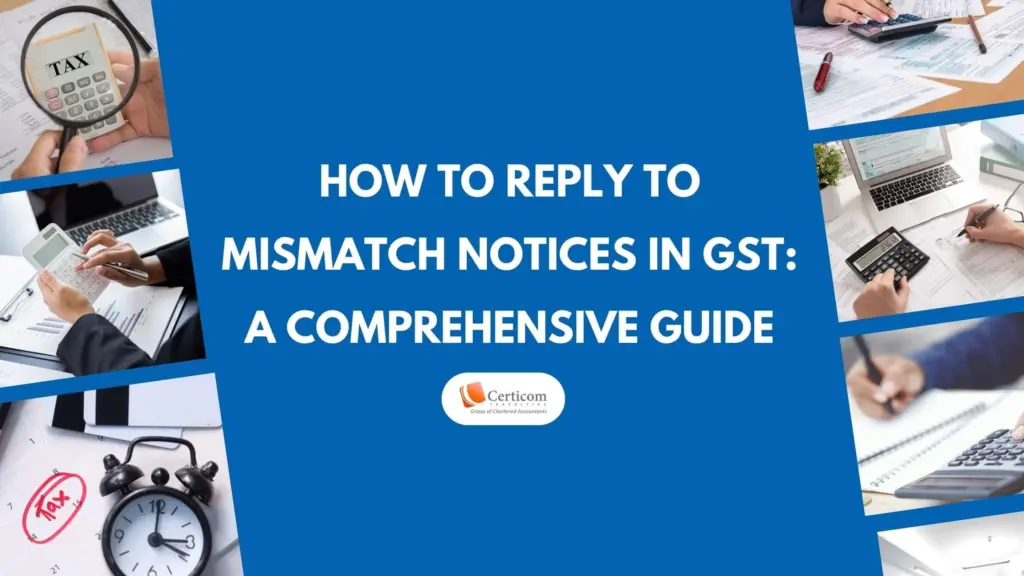How to Reply to Mismatch Notices in GST: A Comprehensive Guide

Under Section 61 of the CGST Act, 2017, GST officers scrutinize returns to identify discrepancies, particularly mismatches between Input Tax Credit (ITC) claimed in GSTR-3B and the auto-populated data in GSTR-2B. When discrepancies exceed specific thresholds (e.g., 5% or 10%), notices are issued to taxpayers. It is crucial to provide timely explanations or take corrective actions to avoid audits, inspections, or tax assessments. Here’s how you can efficiently address these notices.
Key Steps to Respond to GST Notices
Understand the Communication Date:
The communication date is the date you receive the SMS or email notification sent to the registered email ID listed on the GST portal.Download the Notice:
Navigate to the “Services” tab on the GST portal. Access and download the notice from the “Additional Notices” section.Assess the Discrepancy:
Identify and analyze the discrepancies mentioned in the notice. Common scenarios include:ITC Claimed but Not Reflected in GSTR-2B:
Solution: Pay the unmatched tax amount along with 24% annual interest via DRC-03. Additionally, request the supplier to file or rectify their GSTR-1 return.Credit Notes Missing in GSTR-3B:
Solution: Reverse the ITC and pay the required amount with 24% annual interest.Unpaid Reverse Charge Mechanism (RCM) ITC:
Solution: Pay the RCM liability with 24% annual interest.
For other discrepancies, reconcile your records and address ineligible ITC claims by paying the necessary GST liability along with applicable interest.

Reconciliation Process
Reconciliation is a critical step to ensure the ITC claimed in GSTR-3B aligns with the ITC reflected in GSTR-2B. A detailed reconciliation table can help:
| Particulars | IGST | CGST | SGST | Total |
|---|---|---|---|---|
| ITC Claimed in GSTR-3B | ||||
| Add: ITC Not Yet Claimed (specify reasons) | ||||
| Add: ITC from F.Y. 2023-24 (appearing in F.Y. 2024-25) | ||||
| Less: ITC Claimed from Previous Year | ||||
| Rounding-Off Difference | ||||
| ITC as per GSTR-2B |
Attach supporting invoices, credit notes, and payment proofs to substantiate the reconciliation.
Drafting a Reply
When responding to the notice, ensure your reply is clear, accurate, and well-documented. Follow these best practices:
Reference Relevant Provisions:
Mention applicable sections and rules from the CGST Act to support your explanations.Provide Reconciliation Details:
Include a comprehensive reconciliation statement detailing ITC differences with appropriate justifications.Attach Supporting Documents:
Provide all relevant documents, such as:Tax invoices
Credit notes
Payment proofs
Reconciliation tables
Use Professional Language:
Maintain a formal tone, ensuring your explanations address all points raised in the notice.

Outcomes of the Reply
If Explanation is Accepted:
The proper officer will inform you, and no further action will be taken.If Explanation is Inadequate:
Unsatisfactory responses or failure to take corrective actions may result in:Departmental audits (Section 65)
Special audits (Section 66)
Inspections, searches, and seizures (Section 67)
Tax determinations under Section 73 or Section 74
Receiving a mismatch notice under Section 61 of the CGST Act can be daunting, but a structured approach can simplify the process. By understanding the notice, reconciling discrepancies, and providing a well-drafted reply with supporting documentation, you can effectively address the issue and minimize the risk of further litigation. Remember, timely and accurate responses are critical to maintaining compliance and avoiding penalties.
Related Post
ITR Updates for AY 2025-26: Key Disclosures Under Old Tax Regime
Can You File Income Tax Return Without a PAN in 2025? Here’s What You Need to Know
Book A One To One Consultation Now For FREE
How can we help? *




